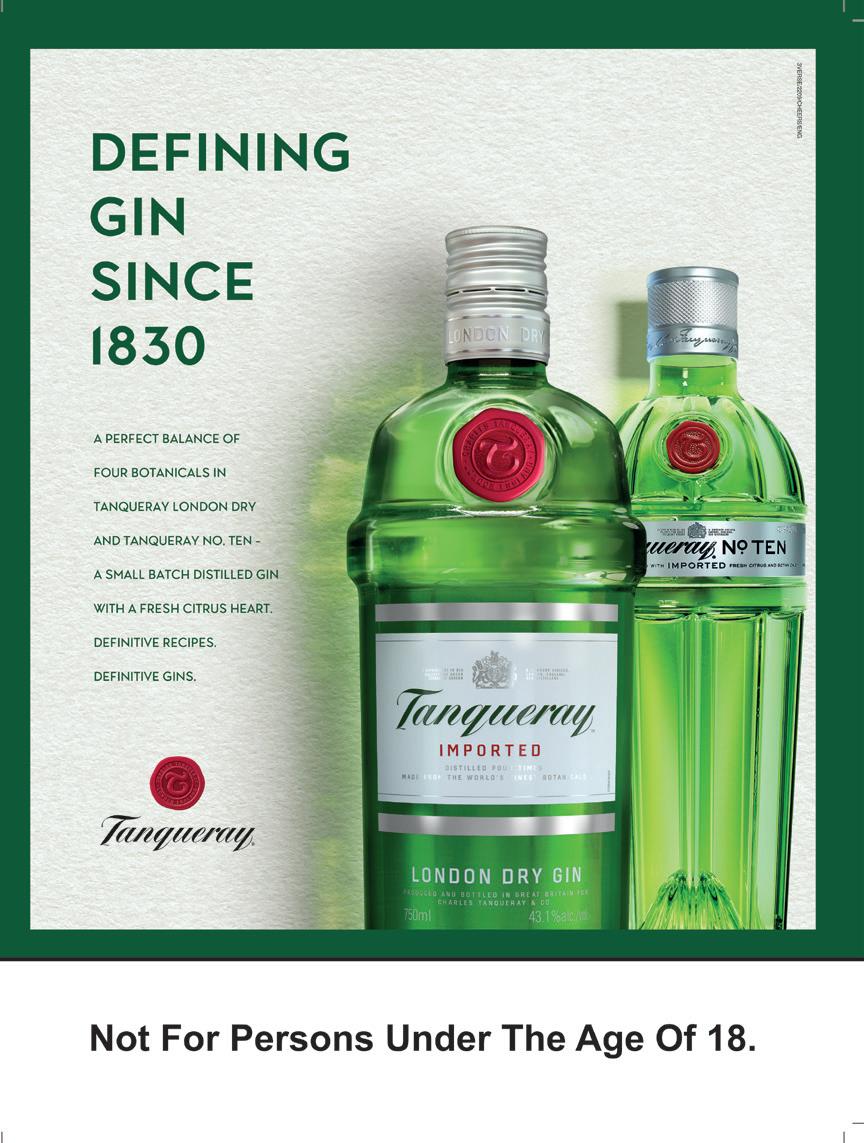
33 minute read
NEWS SCOOP
SCOOP THE
AWARDS ADD UP FOR KWV South Africa’s KWV Cruxland Gin is on a roll, having recently won International Spirit of the Year 2019 at the World Spirits Awards as well as being pronounced the best South African London Dry Gin at the World Gin Awards.
Advertisement
As a result of the Spirit of the Year award, a double gold medal for Cruxland Gin and a further seven gold medals for a range of KWV brandies, the KWV was also classifi ed a World-Class Distillery for 2019 by the World Spirits Awards.
“This is only made possible through the hard work, passion and dedication of our whole team,” said Ilse du Toit, the KWV’s Blending Manager. “To have been recognised and awarded these awards amongst some of the world’s best distilleries is a tremendous honour, not only for us but also for the country.” Since its inception in 2004, The WorldSpirits Awards (WSA) has established itself as the global benchmark in the world of spirits. The credibility of the WSA lies in the expert knowledgeability of the jury, based on their meticulous training and the unique underlying system of assessment.
Distilleries from 25 diff erent nations participated in the World Spirits Award 2019 with 493 spirits submitted from 117 distilleries – more than 90 of them being gin!
Cruxland’s infusion of eight exotic signature botanicals and rare Kalahari !N’abbas is a world-fi rst. Also known as ‘Kalahari truffl es’, this unique
ingredient grows in the
Kalahari region and is only harvested after the fi rst rains by those who have the rare skill to fi nd this gem of the desert. The judges commented on the Gin’s masterful variety spectrum calling it exciting and fresh with delicate juniper aromas and fl oral aspects. BABOONS, FLOWERS & WINE South Africa’s people are culturally diverse, as are the various provinces – from the dry Karoo to sub-tropical KwaZulu-Natal, the oceans are cold in the west and warm on the east coast and the country’s wines are too.
Vondeling, a wine farm in the VoorPaardeberg region near Paarl, has a blended white wine which encapsulates this magnifi cent diversity in its blend of Chenin Blanc, Viognier, Roussanne and Grenache Blanc. The wine – Vondeling Babiana – also pays homage to a unique little plant which is found ONLY on the slopes of the Paardeberg, in the wine farm’s backyard.
The Babiana Noctifl ora is an endangered species and is a delicate, pale creamy yellow tubular fl ower with a sky-blue stamen. It’s a member of the Iris family and takes its name from
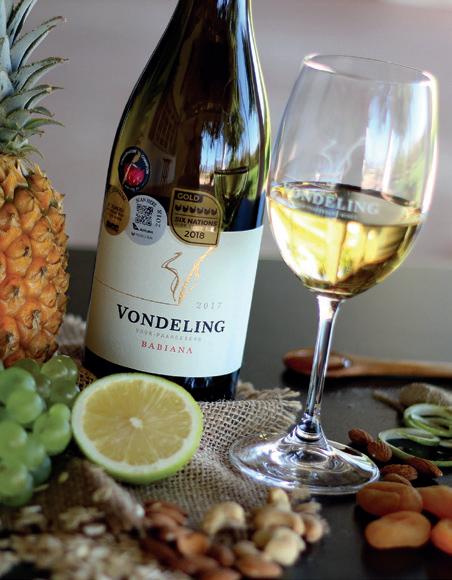
the Dutch word baviaantje meaning little baboon because early settlers noted the primates eating the corms of these plants. The Noctifl ora part of the name comes because its releases a strong scent at night to attract a rare moth which pollinates it.
The newly released vintage of Vondeling’s Babiana is the 2017 and MD Julian Johnsen said the age and low yield of the old Chenin Blanc vines planted in 1986 ensured consistent quality and concentration. “That’s why the Chenin forms the backbone of the blend.” The aromatics and verve of the Grenache Blanc, Viognier and Roussanne temper the older Chenin’s full richness.
Winemaker Matthew Copeland praised the vibrant, textured palate, saying it reminded him of white pepper, jasmine, creamy lemon meringue all supported by subtle oak.



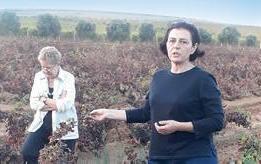

TASTING HISTORY Meerendal, one of South Africa’s oldest wine estates celebrated an historic milestone with a very special wine tasting of Pinotage from a single vineyard which has survived and produced grapes for the past 55 years. Local mountain bikers love the Durbanville property for its challenging climbs and great tracks, but its primary function is grape growing and wine making, boasting the oldest vineyards in the region. Its Heritage Block Pinotage planted in 1955 is one of the four oldest remaining Pinotage vineyards in South Africa.
Meerendal is one of a few wineries with a bottling history dating back to the sixties, making a retrospective sampling of the history of its wines possible – even though many of those bottles had to be bought back! The vertical tasting started with the fi rst ever Meerendal Pinotage from 1969, followed by the fabled 1974 vintage, a 1978, 1982, 1996 and then the fi rst ever single-vineyard bottling of the fl agship Heritage Block Pinotage from 2005.
To coincide with this 50th anniversary, a new wine, The Pinotage Vine, was released – and it’s a departure in style and making from everything that has gone before. Wine maker Liza Goodwin (above) said it shows Pinotage’s versatility. Wine from the 2016 vintage was made and matured in barrel for 11 months – before the fresh skins of the 2018 Heritage block grapes were added. It then spent a further seven months in small French oak barrels before bottling. This unusual technique added a new dimension of fl avour which Goodwin described as elegant and full-bodied with layers of savoury aromas. Lovely ripe dark plum fl avours linger on the palate and are complemented by soft, silky oak tannins. Since this old vineyard is showing the wear and tear of the past fi ve decades, Meerendal has combined with Vititec, the SA leader in vine plant material improvement, to identify, treat and clean some of the best vines of the 1955 Heritage block. The new planting material will be used to fi ll the gaps in the old block. In this way the DNA of the original vines from Professor Perold, the founder of Pinotage, will be preserved.
VISUAL CONSTANTIA FEAST Two decades ago there were just three or four wineries in the Constantia wine region. Now there are a dozen or more and one of them has just released a richly visual book detailing its transformation from forest plantation and cattle stud.
Constantia Glen – A timeless vision captures the life and times of this boutique wine estate through its early history and eventual transformation from forest land into one of the Cape’s premier family owned wine estates which sees thousands of visitors fl ock to it every week.
Researched and written by author Clare O’Donoghue and stunningly illustrated by photographer Craig Fraser, the book is a celebration of Constantia Glen’s prowess. Although it’s a historical account, rich in scale, it is also the intimate story of the Waibel family whose determined vision is underwritten by a deep love for the land they have nurtured over four generations.
Boasting some of the most jaw-dropping views in the Cape winelands, the 60 hectares of undulating landscape have been in the Waibel family, a textile dynasty from Dornbirn, Austria, since the late 1950s – fi rst as forest, then an Angus stud before returning to vineyard. The fi rst vines were planted in 2000 with the very fi rst vintage of Sauvignon Blanc harvested in 2005.
Constantia Glen is open from Sunday to Thursday from 10h00 until 18h00 and on Fridays to Saturdays from 10h00 until 20h00. Look out for the Constantia Glen signs towards the top of Constantia Main Road. Call 021-7955639, e-mail reservations@constantiaglen.com, visit www.constantiaglen.com,
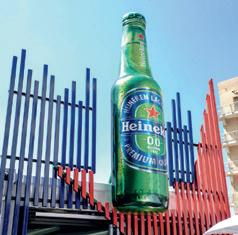
ZERO RATED Life is all about the choices we make. Heineken, one of the world’s most recognised beers are taking their responsibilities seriously and urging beer lovers to do the same.
Heineken 0.0 has been launched in South Africa, an alcohol-free lager brewed with a unique recipe to provide a typically crisp beer fl avour but with no alcohol and a scant 69 calories per 330ml bottle.
The brand’s iconic green label has been turned blue – the colour associated with the alcohol free category. Master Brewers of Heineken’s beer created the new alcohol free beer using only natural ingredients, resulting in a beer brewed for beer lovers, by beer lovers.
“Removing alcohol from regular 5% Heineken beer would have been easy, but it wouldn’t deliver the best tasting non-alcoholic beer,” said Willem van Waesberghe, Global Craft and Brew Master. “Heineken 0.0 beer is brewed from scratch and has a perfectly balanced taste with refreshing fruity notes and soft malty body.”
“Heineken 0.0 opens up new occasions for beer lovers or those making healthier lifestyle choices, without having to compromise on taste. Now you can enjoy the unique and refreshing taste of Heineken 0.0 any time of the day, whether after exercise or while watching an early morning game,” said Heineken Marketing Manager, Lauren Muller. Photograph by Corrie de Vries
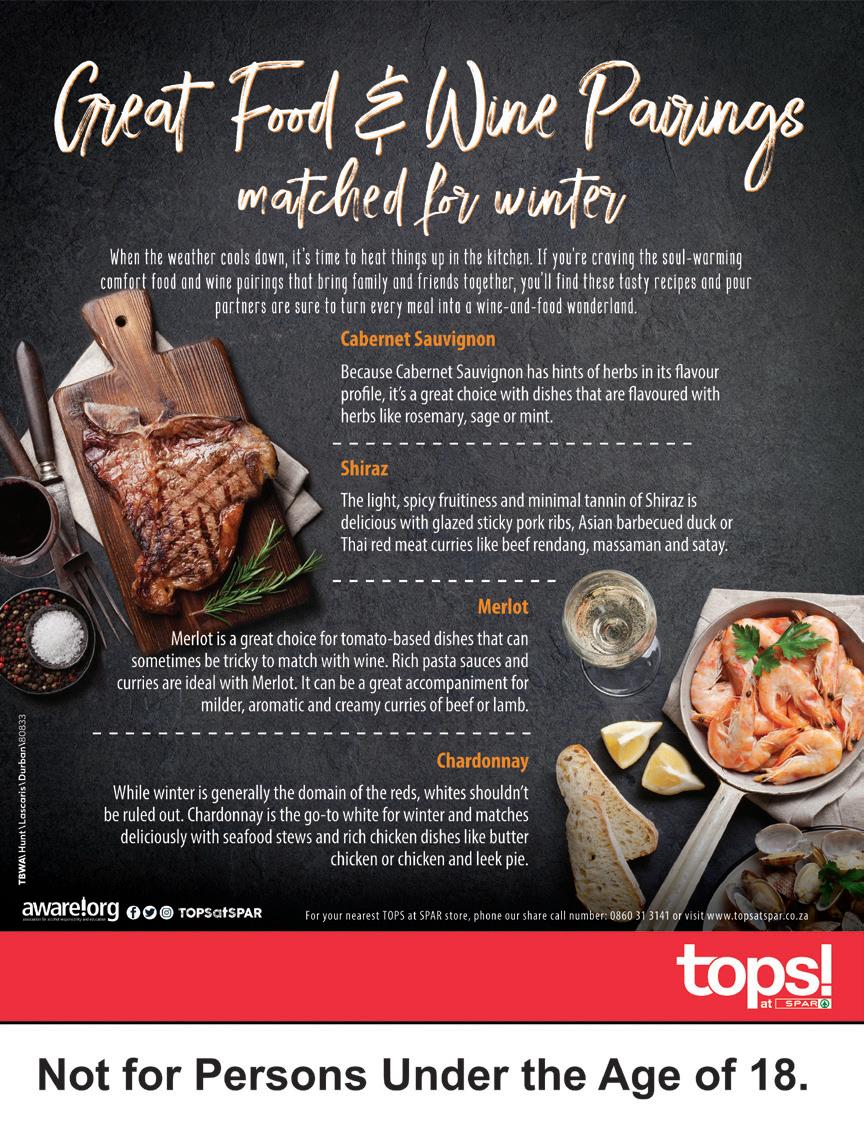
ELLIES IN EQUILIBRIUM There’s a new game in town – and it involves wine and elephants!
Balance, the quirky range of wines made for everyday enjoyment, has released a new online game which has perfected the fi ne balancing act of having loads of fun while caring for the environment.
By helping Hank the elephant balance his way on a unicycle back to his ancestral desert home, players stand a chance to win Balance Bucks, redeemable when purchasing wine at the Balance online store. Balance Bucks can be redeemed after each stage of the game. For Balance Bucks redeemed after completing the fi nal stage of the game, a donation will be made on your behalf in support of the Elephant Human Relations Aid (EHRA) PEACE project. This educational initiative promotes the peaceful cohabitation of local communities with desert-adapted elephants in Southern Africa.
The Balance game is compatible with smart devices and PCs and can be accessed directly online at https://balance.wine without having to download an app or the game itself. The game can also be accessed through a QR code found on Balance wine bottles.
Players need to complete three levels by making Hank tilt and jump to miss obstacles and score points by collecting fruit reminiscent of the rich fl avour spectrum found in Balance wines. Discount coupons in the form of Balance Bucks from R20, R40 to R60 respectively can be won after the completion of each level, depending on your score. The fi nal level culminates with Hank travelling through the desert to join a herd of elephants.

BEERY CO-LAB The Proclaimers had a hit with their song about walking 500 miles for love but how far would hopheads go for unique beer?
Newlands Spring Brewing Company, the crafty arm of brewing behemoth ABInbev (ex-SABreweries), has collaborated with Elysian Brewing Company from Washington in the United States – also part of the ABInbev stable.
The resultant limited edition special brew is called 10,000 Miles Fresh Hop Ale and is a fruity, medium-low sweetness IPA with fi rm bitterness. Elysian Brewing Company’s brewing ingredient specialist Markus Stinson co-opted the help of Newlands Spring brewer Warren Wiese in the project – and travelled out to South Africa in March to arm wrestle over the beer.
Ultimately 13 varieties of hop and three of malt were used. “We drove to George, the only place in South Africa where hops are grown, picked the hops and drove back with 50kg of Southern Passion and 20kg of African Queen,” said Wiese. The beer is a wet hop beer, made within six hours of the hops being picked. “They had an incredibly fresh smell and you could see the quality was great.” A fresh hop beer is made by adding a large amount of hops at the end of the brew house process, giving less bitterness and a bright fruity character for maximum fl avour.”
The brew house process used only local hops (Southern Passion and African Queen), and when the wort was added to the ferment
vessel, the American hops were put into play. US varieties used were the Pink Boots Blend (Loral, Mosaic, Simcoe, Sabro and Glacier), and the Veterans Blend (Cashmere, Centennial, Ekuanot, Mosaic, Simcoe), Amarillo and Eureka! The Pink Boots Society, which releases the annual hop blend of the same name, is an international non-profi t organisation supporting women in the brewing profession, while the Veterans Blend supports US war veterans.
Wiese said beer fans could expect an “intriguing nose of ripe mango, passionfruit, some grassy notes, a little guava, some light lemon hints and red berries and on the palate a medium low sweetness, balanced with a fi rm bitterness and a light honey malt character”. PASTEL PINK CHARMER Bubbly is big – and growing in popularity. Everyone loves a little celebratory fi zzy wine to start either an event, a party or simply to lift the mood over a weekend.
Robertson winery has added a delicately pink dry sparkling wine to their range of bubblies. The Robertson Sparkling Brut Rosé joins the Sparkling Brut, Sparkling Sweet, Sparkling Sweet Rosé as well as the non-alcoholic Sweet White and non-alcoholic Sweet Pink.
The wine has an appealing gentle strawberry colour and off ers up fl oral and candied fruit aromas but the wine remains delightfully dry in the mouth. It’s lively, fresh and vibrant with ample bubble and eff ervescence and when enjoyed well chilled, is guaranteed to lift anyone’s mood.
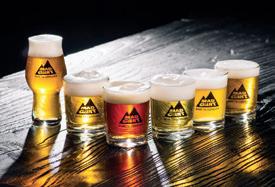
JOZI BREWER Named the Grand Champion at the 2018/2019 African Beer Awards, as well as the Best Pale Ale, was the Mad Giant’s Killer Hop.
“Mad Giant is about the ordinary person that’s crazy enough to pursue a massive dream,” says brewmaster and founder Eben Uys.
Thirty-something Uys, who obtained his PhD in chemical engineering at Stellenbosch University, is both chemist, beer lover and father and takes his environmental responsibility seriously – so is only packing his brews in cardboard.
The brewery was fi red up just three years ago with a simple aim: to brew beer for happiness. They soon realised the only way to smack a smile on, as Mad Giant’s tagline howls, is when you know your impact on the planet and people. “Plastic has become a massive pollutant of our rivers and seas. We don’t have an option but to start a journey of eradicating plastic.
“It’s our responsibility to be friendly to the environment; I want to create a legacy worth something to the next generations.”
Using cardboard has increased costs ten-fold. “Paper labels are almost double the cost and they don’t last as well in an ice bucket. But we cannot imagine the future cost of trying to clean the ocean and breeding sea life from scratch.”
STEEN WITH THE STEINS In days of yore, Chenin Blanc was known locally as Steen – and coincidentally, this style of wine will be among the many featured in a brand new 13-part television series about the Durbanville wine valley.
Renowned celebrity chef Rick Stein’s two sons, Charlie and Jack pictured above, spent a big chunk of the South African summer fi lming in and around Durbanville while grapes were being harvested and vinifi ed.
The series, Wine, Dine & Stein was produced by local outfi t, Oxyg3n Media, and has already been pre-sold to the UK, Denmark, Norway and Poland with more countries lining up to acquire the show. It will also be seen in SA later this year on a yetto-be announced channel on DStv.
Created by JAG Communications’ Grant Bushby and Janine Walker, Wine, Dine & Stein fi nds the Stein siblings spending a day on each of the 12 wine farms that make up the Durbanville Wine Valley, tasting their wines, sampling (and helping cook) their food and embarking on a series of dares and challenges.
Some of the more interesting activities the “boys” got up

to – while not eating and drinking – included paragliding off Hamburger Hill at Meerendal, fi ring the Big Bertha cannon at Signal Gun, taking part in a wheelbarrow race at Klein Roosboom, rounding up cattle via quadbikes at Groot Phesantekraal and wakeboarding at the Hillcrest quarry.
Like his father Rick, Jack Stein (38), is an accomplished chef and author and, apart from presenting TV series, also oversees the kitchens of all 14 Rick Stein restaurants. Brother Charlie (34) works for The Vintner wine merchants in London and also helps taste and select all the wine for the family’s restaurants.
“I had the most fun I’ve had in ages fi lming this series and I can’t say enough about the warmth, hospitality and generosity of the people we met, not to mention the amazing food we ate and the brilliant wines we drank,” said Jack.
“Each and every wine farm in the valley off ers something diff erent from the other,” said Charlie. “From the small boutique, but utterly charming Klein Roosboom, to the bigger estate that is Durbanville Hills – but which still manages to convey a feeling of family.” “Each and every wine farm in the valley off ers something diff erent from the other,” said Charlie. “From the small boutique, but bigger estate that is Durbanville Hills – but
ITALIAN INSPIRATION The world over people love all things Italian: the food, the music, the culture with its passion for life but particularly the wines. The late Anthonij Rupert did too – and believed that Italian wine grapes would be well suited to South African growing conditions. Decades ago he pioneered their introduction and was the fi rst to produce Sangiovese and Nebbiolo wines locally.
Sadly, he was tragically killed in a vehicle crash some years ago but his wines live on in the Terra del Capo range which has grown and fl ourished under the supervision of Anthonij’s brother, Johann Rupert.
The Terra del Capo range currently consists of two reds (the Sangiovese and the Arné red blend which is a Sangiovese and Merlot) and one white, Pinot Grigio. The wines are light, supple and perfectly suited to enjoy with food and friends.
Since 2011, the home of Terra del Capo at Anthonij Rupert Wines near Franschhoek has been revamped into the beautifully designed and Italian-inspired Terra del Capo Tasting Room. Drawing on Franschhoek’s reputation for breathtaking scenery, award-winning wines and local, produce-driven cuisine, the Terra del Capo Tasting Room is informed by all the good things in life – what the Italians refer to as la dolce vita, or ‘the sweet life’ – transforming wine tasting and food pairings into a relaxed, indulgent experience in elegant surroundings.

CHARM PERSONIFIED The fast-paced hustle and bustle of life is stressing people out! There’s a need to push the pause button, get off the hamster wheel and just engage in a meaningful way with things that are pleasant and fun.
The Old Road Wine Co. is a new undertaking which is looking to not take itself too seriously but still be positive about the local wine fraternity. As their marketing blurb states, whether consumers are sinners, saints or sages there is something for everyone in their layered collection of wines which cut across a range of new wines, old vines and even critter labels – because it’s all about the stories ... Each wine tells a tale of real characters in the Cape winelands during the 19th century, full of colour and charm, at a time when Franschhoek was somewhat adrift from the industry. Expect to fi nd stories about a mischievous station master, a hungry dog, a misfi ring butcher, poor blacksmith, gossiping ‘smous’, industrious grandmother and a trusted postman.
The tall tale isn’t enough to make a repeat sale so winemaker Ryan Puttick has ensured that the fermented juice in the bottle is equally engaging.
“The Old Road Wine Co. off ers wines that deliver something interesting and highly enjoyable at various tiers and price points, which is so important in a marketplace with so many diff erent wants and needs,” said Tim Hutchinson, one of the investors behind this novel concept. FLYING HIGH Benguela Cove lagoon wine estate is a rather special place – with mountain, sea, vineyard and lagoon views in abundance. While its visitor off ering ranges from unique pirate treasure hunts for children to High Tea or oyster samplings for adults, it’s the wine which is fi rmly front and centre. Cellarmaster Johann Fourie could – if he wanted to – actually make 360 individually unique Sauvignon Blanc wines off the property! That’s because of the multitude of soils, vineyards, clones and even diff erent fermentation vessels that he has to play with ... from clay and shale soils, six individual Sauvignon Blanc grape clones, all the way through to wooden vessels, concrete eggs and clay amphora!
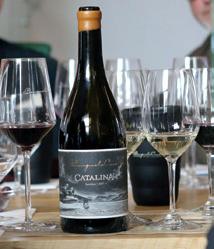
“What makes Benguela Cove an exciting wine estate to work with, is its great diversity of soil and slopes and the variety of cultivars planted here. An added bonus is the close proximity to the ocean that ensures a cooling eff ect with welcoming breezes to keep the vineyards healthy and disease free,” Fourie said.
“We want to share this with the public and invite them to discover Benguela Cove. The Vinography range represents a journal or diary for the estate, hence the name, capturing the ongoing process. One can never become complacent. If you don’t try something, you might never know what the outcome could’ve been.”
And his inveterate experimentation found its ultimate expression in the super-premium fl agship off ering which announced its presence with top ratings from Platter, critic Tim Atkin and various other awards – the Catalina Semillon from 2017. It’s from a single vineyards, less than one hectare in extent which delivers exceptional quality – and longevity. With just 1 400 bottles made, the team advocate only approaching it after 10 years. It’s also a homage to the Catalina fl ying boats which operated from the Bot River lagoon during World War II.
LEADING THE (SCOTTISH) WAY Jointly presented by TheDrinksReport.com and Whisky Magazine, the World Whiskies Award is among the highest profi le whisky awards on the planet – with judges comprising journalists, members of the whisky trade and industry experts selecting only the best across a range of internationally recognised styles.
Scottish Leader’s rich and silky fl agship, the 12-year-old, won a gold medal for Scotch blended whisky in the 12-years and under category for the second year in succession. Behind the growing appreciation for this blended spirit sold in 30 international markets, is a talented team headed by Dr Kirstie McCallum, a chemist by training and one of the fi rst women in Scotland to become a whisky maker.
In the blend are some of the fi nest unpeated Highland and Speyside malts, combined with Scottish grains for a smooth, approachable style. The majority of the Highland and Speyside malts selected are matured in American oak casks which contribute toward the rich oak and vanilla characteristics, and the fruity, fl oral elegance.
“This impressive spirits continues getting international recognition. Apart from the gold medals achieved for two consecutive years, in 2018 and 2019 at the World Whiskies Awards, it also earned gold at both the 2016 and 2017 editions of the International Spirits Challenge (ISC), a gold outstanding medal at the 2015 International Wine & Spirit Competition as well as ‘master’ status at the 2015 The Spirits Business Global Scotch Whisky Masters competition,” said global marketing manager Liezl Dippenaar. “Scottish Leader 12-year-old truly provides outstanding quality and fl avour, showcasing the consummate skills of our blending team. It really means a lot to this dynamic brand that stands for the richer possibilities, brought on by taking a new perspective.”
SOMETHING NEW FROM SPRINGFIELD Springfi eld Sauvignon Blanc is a staple of the South African summer. Crisp, zesty and refreshing, it matches any occasion when the sun is shining.
But the Bruwer family of Robertson who produce this popular tipple have even better news for adventurous wine lovers: a brand new wine!
Springfi eld Albariño was launched in suitable style with platters of prawns, battered hake and chips at an iconic Hout Bay landmark, the Chapman’s Peak Hotel. Only the third Albariño to make it to the South African market, Springfi eld state that this wine is – like their popular Sauvignon Blanc – intended for friends, food and fun times.
Albariño is a popular grape grown in Spain and Portugal where it is known to pair well with seafood on account of its brightly vivid acidity and fresh lemony fl avour.

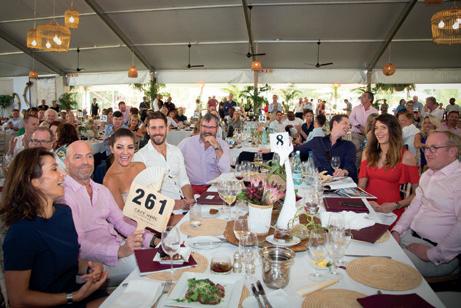
AUCTION RAISES MILLIONS In only the sixth staging of the event, the Cape Wine Auction raised nearly R15 million specifi cally for education in the winelands, bringing the tally raised to date to just under R88 million.
Held at Buitenverwachting in Constantia earlier this year, the Cape Wine Auction is acknowledged as one of a handful of high-profi le wine auctions worldwide which does a phenomenal amount for charity.
The auction has created a benchmark in philanthropy, with 100% of proceeds going to 22 benefi ciaries, all of whom have had a profound impact on education and the lives of children in the Cape winelands. “At a time when South African education is in crisis and donor fatigue is on the rise, the Cape Wine Auction Trust is now more important than ever,” said Darielle Robertson, director of The Cape Wine Auction. “We are delighted with this year’s results, and it means we can continue with our programmes and see a tangible diff erence.”
Highly sought-after curated lots went under auctioneer Dan Nichol’s hammer with the top price of R3 million bid for an exclusive Marovasa Be experience in Madagascar while a further R1 million was paid for The Man & Soil lot which was a joint venture between Ashbourne’s Emul Ross and ‘rock star’ winemaker Eben Sadie.
CAPTURE THE MOMENT It’s the ultimate selfi e moment ... having your friends feature on the packaging of a limited edition 3L bag-in-box wine! In a fi rst for South Africa, Drostdy Hof is featuring the special moments of hundreds of South Africans in a photographic collage on each pack.
Towards the end of last year thousands of images were received from wine-lovers nationwide in the #CaptureYourMoments digital campaign, all vying for a chance to have their special moments with their friends and family captured on the limited-edition packs and on Drostdy Hof’s social media platforms.
The range of 3L bag-in-box wines are exactly the same quality wines found in the 750ml bottles and include both dry and sweet taste profi les. Convenient and hassle-free, the environmentally friendly box wines are the perfect addition to any occasion. The Drostdy Hof Natural Sweet White is delicate and fruity with a crisp, sweet fi nish whilst the Drostdy Hof Natural Sweet Red is a light and fruity red with a smooth fi nish. The vibrant Natural Sweet Rosé is a fun combo of strawberry, cherry and plum fl avours. The Drostdy Hof Claret Select displays upfront strawberry, mulberry and ripe red fruit fl avours. The Adelpracht is a full and rich wine with dried apricots and peaches, at touch of honey and fl oral notes balanced with a lovely acidity.
Check out the packs to see if you can either spot yourself or your mates!
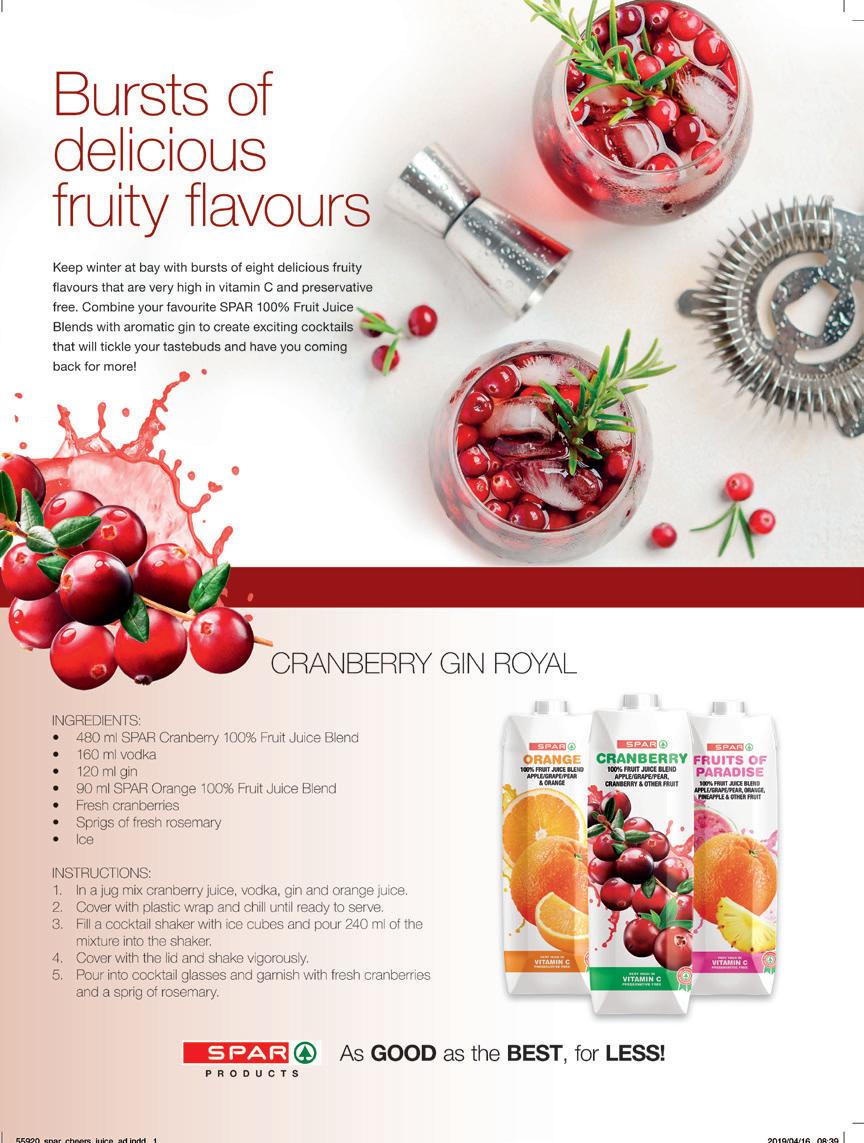
TWIST SPIRITED
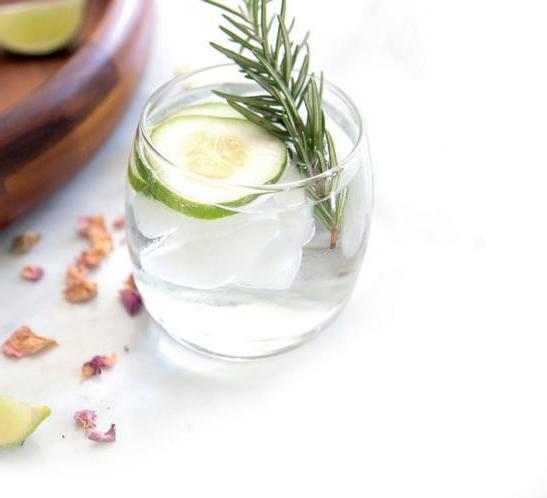
REPORTS OF ITS PREMATURE DEMISE MIGHT BE DOING GIN A DISSERVICE – AND ALSO FALL INTO THE CATEGORY OF “FAKE NEWS”. IN SOUTH AFRICA THERE ARE NO SIGNS OF THE GIN CRAZE DISSIPATING. FIONA MCDONALD REPORTS.
Elephants are such a powerful symbol of Africa. They’re renowned for their family bonds with herds led by strong matriarchs, cows who know where the waterholes and best grazing are, whose instincts to protect their young are fi erce and whose memories are legendary. Sipping a gin and tonic while the sun sinks into the African bush is the stuff of movies, storybooks and lifetime bucket lists. And it’s precisely what South Africans Les and Paula Ansley did while on safari in Kenya. Whether it was the gin in her glass which prompted Paula’s idle musing or a snippet of conversation from the ranger which prompted Indlovu gin’s birth is not exactly clear. That Indlovu gin is the most unique of a recent spate of products coming out of South Africa is beyond question – because it is made using elephant dung! (Indlovu is the Nguni word for elephant, by the way ...)
Elephants are notoriously bad digesters. They eat a lot of food during the course of the day – up to 200kg of foliage – but a large percentage of that remains undigested. Elephant dung has been used in traditional medicine or specially brewed teas in Africa for many years, so why not in gin? Paula Ansley thought. Roger Jorgenson of Wellington, a man who has trained legions of local distillers, helped them perfect their
EBONY ROSE
60ml Musgrave Pink Gin Blackberry Jam (*must use jam not syrup) Fitch and Leedes Tonic Fresh Lemon Crushed Ice GARNISH: Blueberries or blackberries and Lemon Rind
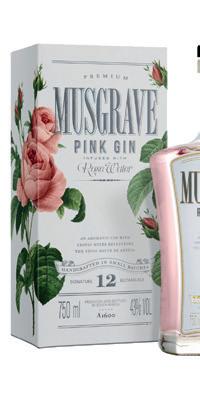
METHOD: 1 Drop a generous dollop of blackberry jam into glass. 2 Thoroughly stir the double shot (60ml) of Musgrave Pink Gin. 3 Fill glass to the brim with crushed ice. 4 Add a generous squeeze of lemon. 5 Top up with tonic. 6 Garnish by placing a few fresh berries onto a cocktail stick and resting on the ice, dress with lemon rind.
product which is described as having “uniquely wooded, earthy fl avours” but gin lovers need not fear: the traditional juniper, angelica and citrus notes of standard or London Dry style gins are also discernible!
Since the Ansley’s are keen on conservation and wildlife preservation, 15% of the profi ts will be going to the Africa Foundation to support their work in conservation through the Phinda Wildlife Project.
The Wine & Spirits Trade Association recently reported that the UK market for gin had doubled in the past two years alone – and more than 73 million bottles of gin, worth £2 billion, were sold last year alone. (In South African money, that’s R38 billion. To place that in perspective, it is almost what Eskom’s Medupi power station was supposed to cost ...)
Elephant dung might be a bit exotic for British tastes, but the good news is that South Africa’s craft gin scene shows no signs of abating, as many local distillers testify.
“South Africa sits on a treasure trove of natural wonders, and gin has been the perfect fi t for presenting our natural bounty to both local and international audiences,” said Stefan Coetzee, managing partner of Bloedlemoen. “It’s a versatile spirit, which leaves a lot of room for creativity and fl air to all those involved in the movement. It focuses on the occasion, sunsets, lazy afternoons with friends, beautiful backdrops and drink presentations.”
Coetzee said one of the reasons the local gin scene has expanded from a handful of examples five years ago to nearly 200, was the speed of development as well as distillation techniques and the abundance of styles and flavour influences.
“There is no sign of slowing down for the category in the local market,” he said. “What is happening is maturation – with serious players being separated from flash-in-the-pan opportunists.” There was a natural culling of those capitalising on the trend from those whose production method and integrity are paramount. “There are very clear differences between the passion and detail from the craft movement and the various players trying to capitalise on it with substandard product.”
Andre Pienaar is the master distiller behind Pienaar & Sons and concedes that there will have to be a cut-off point somewhere. “New brands enter the market every month,” he said, echoing Coetzee’s observations. “The market can’t support an endless amount of gin so the saturation point will be reached at some stage. And then trends are just that – trends! We humans are very distractible animals and the fashion will eventually move to another category, but I believe this is still a long way away.”
ClemenGold’s Charlene Nieuwoudt agreed. “But gin appeals to such a large target audience – gender and age – and the new innovative ways of enjoying it are so diverse that we feel the gin trend will continue for quite a while.”
Musgrave was one of the first noticeably different gins available locally. It has parlayed its subtle pink colour and uniquely shaped bottle into a rapidly growing and loyally supported brand, locally and abroad.
“Before the global gin renaissance, this was a category previously dominated by a few stalwart heavyweight brands which did little to innovate,” Katie
ABOVE: The “son” part of Pienaar & Sons, Andre Pienaar in his happy place – surrounded by gin.

Coetzee, global marketing director of Musgrave said. “With the entry of hundreds of smaller, boutique challenger brands offering rich stories and progressive variations, a new interest in the category was ignited and continued to grow. Gin, unlike wine or aged spirits requiring a reasonably longer time period for production, is very quick to make, so when an ample supply and ample demand collided, the boom happened.”
Originality and continuing to drive innovation would be what kept customers engaged and excited and would ensure sustainability of the various brands, Coetzee said.
“The nature of ‘trend’ is transience and change – it’ll be exciting to watch how producers and brands weather the oncoming storm of saturation in the marketplace following the boom we’ve seen,” she said.
Flavours seen in abundance on local retail shelves include rooibos, Kalahari truffle, buchu and a variety of fynbos as well as lots of citrus. Both ClemenGold and Bloedlemoen celebrate citrus. Nieuwoudt said the easy peeling, virtually seedless ClemenGold mandarin was an aromatic, sweet soft citrus fruit grown in Mpumalanga, Limpopo, Southern and Western Cape.
“Eight botanicals – with sundried ClemenGold peels taking the flavour lead – are used when handcrafting this distillation,” she said. “ClemenGold and orange peel, cinnamon, ground almond, juniper berries, angelica and orris root as well as coriander are macerated
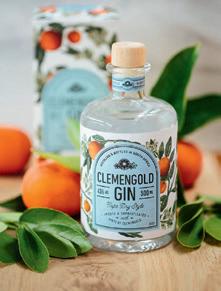
CLEMENGOLD GIN AND TEA 50ml ClemenGold Gin 15ml lime juice 50ml Orange & Rooibos Ice Tea (or other citrus flavour) 10ml ClemenGold syrup* 3 dashes orange bitters A few sprigs of fresh oregano METHOD: 1 Shake ingredients in a cocktail shaker filled with ice. 2 Serve in a rock glass on ice and garnish with a fresh or dried ClemenGold ring. *FOR CLEMENGOLD/CITRUS SYRUP: 250g sugar ½ cup water 2-3 ClemenGold (or other citrus) peels ½ cup lime juice METHOD: 1 Heat in a pan over medium heat until sugar dissolves. 2 Bring to the boil and simmer until it achieves a syrupy consistency. 3 Strain and store for future use. the early 1900’s and mapped a discovery of 11 botanicals used in our gin. Hence the name, Musgrave 11. The thinking behind Musgrave Pink was to package and message a product that embraces femininity in a male-dominated world of spirits.”
And while a cucumber and rosemary garnish work well with Musgrave, Coetzee warned of having too liberal a hand with the tonic. Her suggestion would be to try it with a 50/50 tonic and soda water mix.
Pienaar also had very firm views on garnishes ... “I feel like it has become very gimmicky. The craft gin industry was born because it tasted better than regular gin. Now it feels like if your gin isn’t blue, black, pink, filled with sparkles or doing flick-flacks, it’s boring. Lately it seems to purely be a game of visuals and gimmicks!”
But the South African gin scene doesn’t need to rely on gimmicks or marketing smoke and mirrors. The bounty of local raw materials is so diverse, along with the creativity of its makers that there is no sign of the craze abating anytime soon. and vapour-infused to create this smooth classic Cape Dry style gin.” Blood oranges are not often to be found in South Africa – something Coetzee says is changing. “We use the Tarocco blood orange. It’s deliciously juicy and flavoursome – with quite a unique raspberry-like flavour,” he said. What sets it apart is the presence of ruby colour pigments – or anthocyanins – in the flesh. “It’s the backbone of our gin, balanced by the spicy nuances of nutmeg, cassia, grains of paradise and angelica root to bring you a balanced, textured and complex contemporary gin.”
What might surprise consumers is that all of these spirits will drink well on their own, with a block or two of ice. “If you dolly it up too much with different garnishes, you lose the essence of the gin. With a good local tonic and a dried (or fresh) ring of ClemenGold it’s superb,” said Nieuwoudt.
Bloedlemoen’s Coetzee concurred: “Some Indian tonic and a dried piece of orange and possibly a cinnamon quill or piece of cassia bark,” he advised. But NEVER a slice of lemon – please! Bloedlemoen is orange-based and the lemon would be too tart and acidic. “The general rule of thumb is to use flavour combinations that complement each other, so a good place to start is to use some of the flavours and botanicals prevalent in the product – i.e. fynbos with a fynbos gin, citrus with a citrus gin etc. Sometimes you can go for presentation over function, and garnish with pretty edible flowers and the like.”
Pienaar has – to use his words, “taken more of a cultural approach to celebrate Cape Town culture and its history”. He is of the opinion that local inspiration is great “but it doesn’t have to be a literal one, so we don’t use any fynbos at all in our gins”. The Empire boasts cucumber, lemon, grapefruit and lime leaves while the Orient is redolent with vanilla, rosemary, ginger, all-spice, mandarin orange and cinnamon.
“Tonic is the obvious mixer,” he said, “and I prefer a mild, easy, Indian tonic. Something that just supports the gin and lets it tell the story while not overwhelming it. Our Empire is amazing with cucumber and thyme and our Orient does really well with grapefruit and lavender but generally I’m a big believer in ‘less is more’ when it comes to garnish.” Katie Coetzee of Musgrave agrees with that sentiment, advising two blocks of ice and an African sunset as the ideal pairing. “We don’t follow the fynbos story most others from our region do. We worked with credible experts to create our signature awardwinning recipe that essentially unpacks a tale of adventure and spice, nodding to 11 African botanicals blended and distilled into a very unique flavour profile. “The spice infusion and story comes from our founder’s family-heritage story, as her grandfather came to Africa in
